Persian Food: A Journey Through Iran’s Rich and Flavorful Cuisine
Persian Food: Exploring Iran’s Rich Culinary Heritage
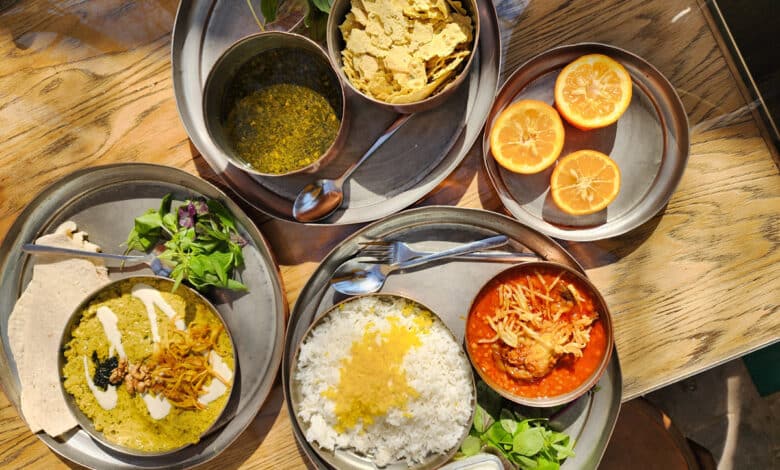
Persian food is a vibrant reflection of Iran’s deep-rooted history and culture. Blending centuries-old traditions with bold flavors, it offers a culinary experience that excites both the palate and the imagination. Every dish tells a story—one shaped by the country’s diverse landscapes, rich spices, and time-honored cooking techniques.
Let’s be honest—when we travel, food is just as exciting as the sights we see. Exploring historical landmarks and breathtaking nature is unforgettable, but tasting new flavors often becomes the highlight of any journey. Whether we admit it or not, we’re all food travelers at heart.
For adventurous eaters, Persian food is an experience like no other. From the fragrant saffron-infused desserts to the comforting warmth of slow-cooked stews, every bite reveals a piece of Iran’s culinary heritage. Get ready to discover the key ingredients, signature dishes, and irresistible flavors that make Persian cuisine a must-try for every food lover.
So, are you ready to indulge in the rich flavors of Iran? Let’s explore what makes Persian food one of the world’s most captivating and delicious cuisines.
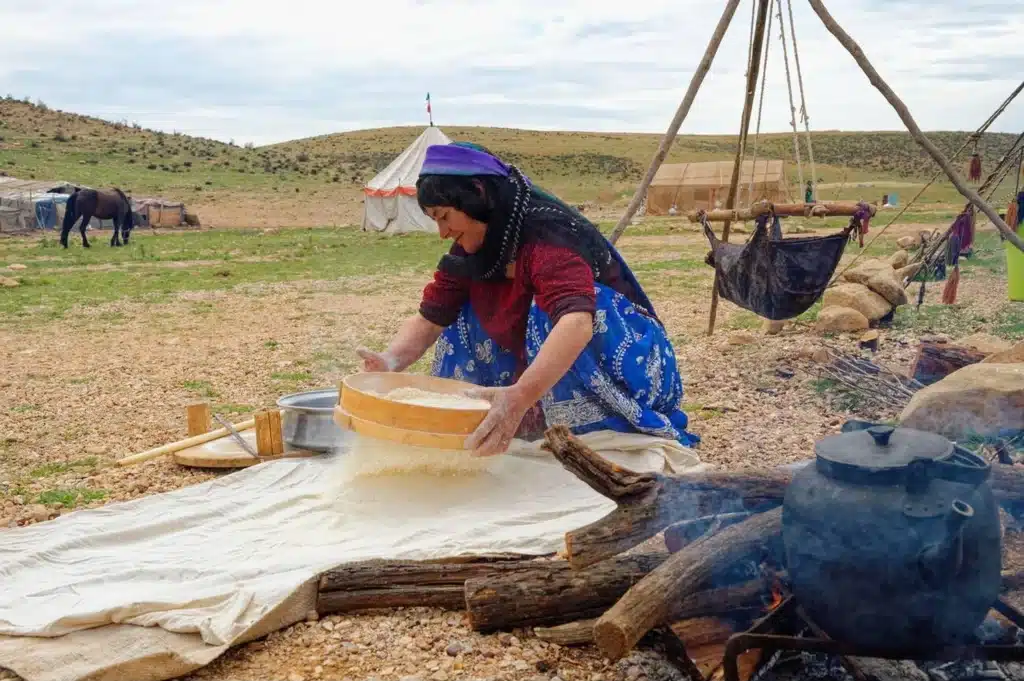
Contents
Introduction to Iranian Cuisine
Iranian cuisine is one of the world’s most ancient and sophisticated culinary traditions, deeply rooted in history and enriched by diverse regional influences. It is a testament to Iran’s long-standing role in global gastronomy, where flavors, ingredients, and techniques have been refined over millennia. Persian cuisine is a delicate balance of sweet, sour, salty, and bitter flavors, with dishes often showcasing fragrant herbs, dried fruits, nuts, and spices like saffron, turmeric, and cinnamon.
From the opulent feasts of the Persian Empire to the home-cooked meals of modern Iran, food has played a central role in Persian culture, symbolizing hospitality, tradition, and identity. The variety of Iranian cuisine reflects the country’s vast geography and cultural diversity—ranging from hearty stews of the north to the spicy dishes of the south, the delicate rice preparations of the center, and the nomadic flavors of the west. Each region brings its own specialties, influenced by climate, available ingredients, and historical interactions with neighboring civilizations.
Historical Background of Iranian Cuisine
Iran’s culinary history is deeply intertwined with the rise and fall of empires, migrations, and global trade routes. Its development spans thousands of years, beginning with the Achaemenid Empire (550–330 BCE), which laid the foundation for Persian culinary traditions. The Persians were among the first to develop sophisticated cooking techniques, including the use of rice, meats, and a wide range of spices and herbs.
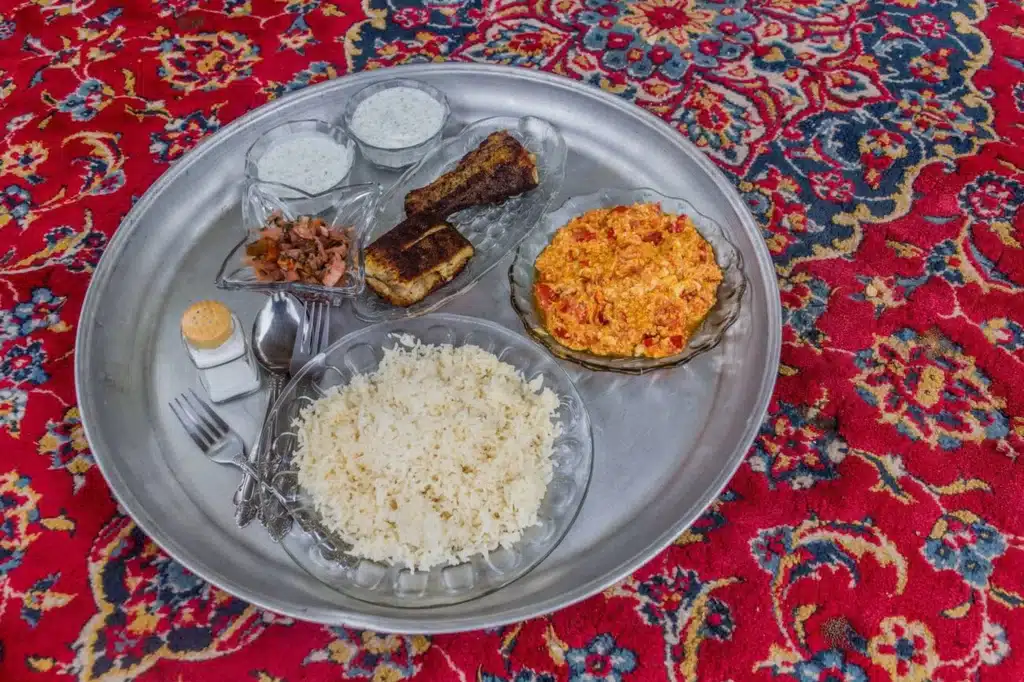
Influence of the Persian Empire
During the Achaemenid and Sassanid periods, Persian food culture flourished, influencing neighboring regions, including India, Central Asia, and the Mediterranean. The Persian court was renowned for its lavish banquets, where dishes were meticulously prepared with exotic ingredients brought through the Silk Road and spice trade. Dried fruits like dates, figs, and apricots, along with nuts such as pistachios and almonds, became staple ingredients in Persian cooking, adding a rich depth of flavor.
The introduction of rice from South Asia revolutionized Persian cuisine, giving birth to Iran’s iconic rice dishes like chelow (steamed rice) and polow (pilaf), which remain central to Persian dining today.
Impact of Trade and Invasions
Iran’s geographic position made it a crossroads of culinary exchange. The Arab invasion (7th century) introduced new spices and cooking techniques, enriching Persian cuisine with ingredients like saffron, citrus, and eggplant. The Mongol invasions (13th century) brought influences from Central Asia, while Turkic and Ottoman interactions introduced grilling techniques and kebabs, which became a staple of Iranian street food.
Persian cuisine also played a significant role in shaping other food traditions, particularly those of India and the Ottoman Empire. The Mughals, who ruled India, adopted many Persian cooking styles, leading to the development of Biryani and Korma, dishes that share deep similarities with Persian polow and khoresh (stews). Similarly, Turkish cuisine owes much to Persian influences, particularly in the use of rice, yogurt-based sauces, and desserts like baklava, which evolved from Persian sweets.
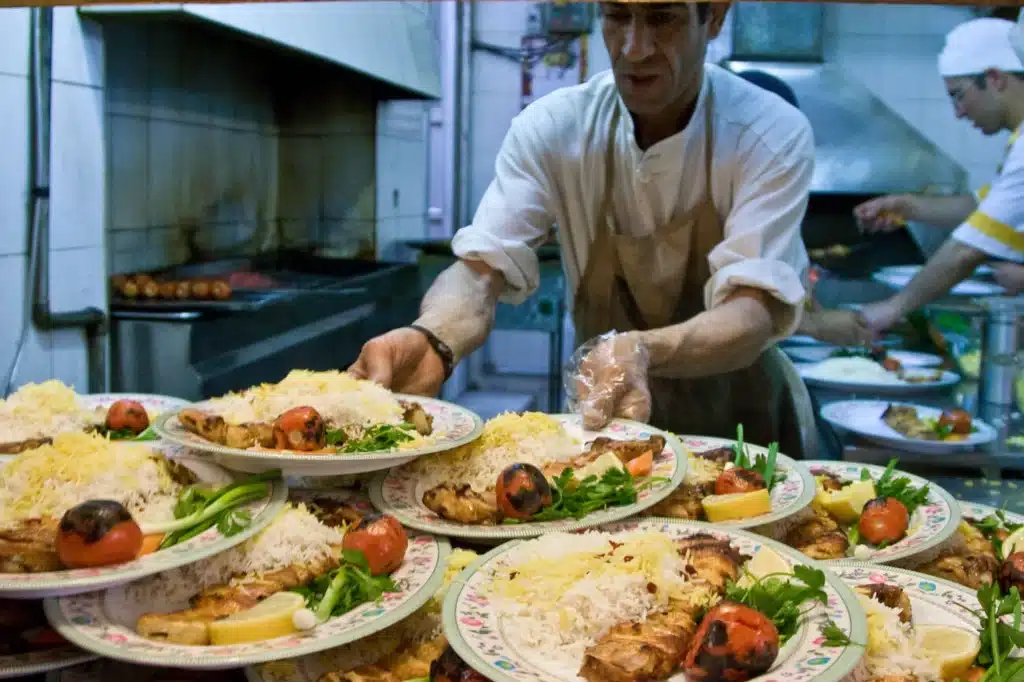
Modern Evolution of Iranian Cuisine
Despite centuries of political changes, Persian cuisine has retained its fundamental identity while adapting to modern tastes and international influences. Today, traditional dishes remain deeply cherished, but Iranian chefs continue to innovate, incorporating new ingredients and techniques. The diaspora community has also played a crucial role in popularizing Persian food worldwide, with Persian restaurants thriving in major cities across Europe, North America, and beyond.
From the royal kitchens of ancient Persia to the bustling food markets of Tehran, Iranian cuisine remains a rich, evolving culinary tradition, offering a unique blend of history, culture, and flavor that continues to captivate food enthusiasts around the world.
Ingredients and Flavor Profiles of Iranian Cuisine
Iranian cuisine is defined by its use of fresh, high-quality ingredients and a harmonious balance of flavors that range from sweet and sour to aromatic and earthy. Each dish is a carefully curated composition of grains, meats, herbs, spices, nuts, and fruits, creating layers of taste that unfold with every bite.
Staple Ingredients in Persian Cooking
Rice (Berenj)
Rice is the cornerstone of Persian cooking, prepared in various styles such as steamed chelow and layered polow with meats, vegetables, and dried fruits. The iconic Persian saffron rice stands out for its rich golden hue and fragrant aroma, making it a signature dish in Iranian cuisine.
Meats (Gosht)
Persian dishes primarily feature lamb, beef, and chicken. These meats are often slow-cooked in stews or grilled as kebabs. In coastal regions, fish is also a popular choice, offering a fresh alternative in Persian meals.
Herbs (Sabzi)
Fresh herbs are essential in Persian cooking, sometimes even replacing vegetables in dishes. Common herbs like parsley, cilantro, mint, dill, chives, and fenugreek enrich stews, rice dishes, and soups with vibrant flavors and aromas.
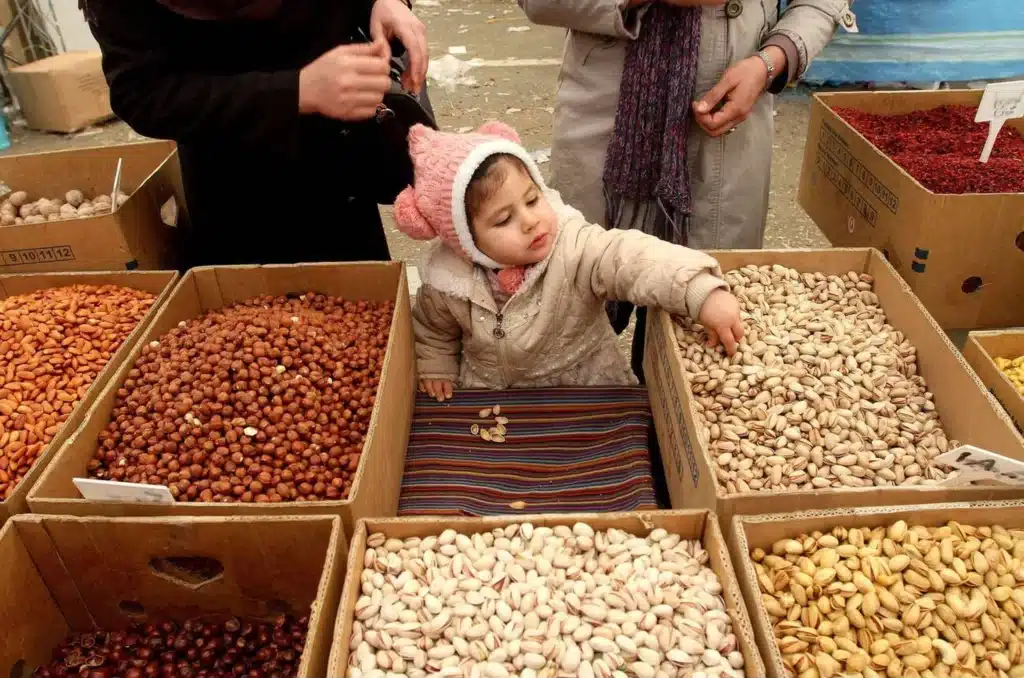
Nuts (Maghz-ha)
Persian cuisine frequently incorporates nuts like pistachios, almonds, walnuts, and hazelnuts in both savory and sweet dishes. These ingredients provide a rich texture and a nutty flavor, enhancing the overall complexity of Persian meals.
Fruits (Miveh)
Fresh and dried fruits contribute a distinctive sweet-tart flavor to Persian dishes. Pomegranates, barberries (zereshk), dates, apricots, figs, and raisins are commonly included in rice dishes and stews, adding a burst of flavor and color.
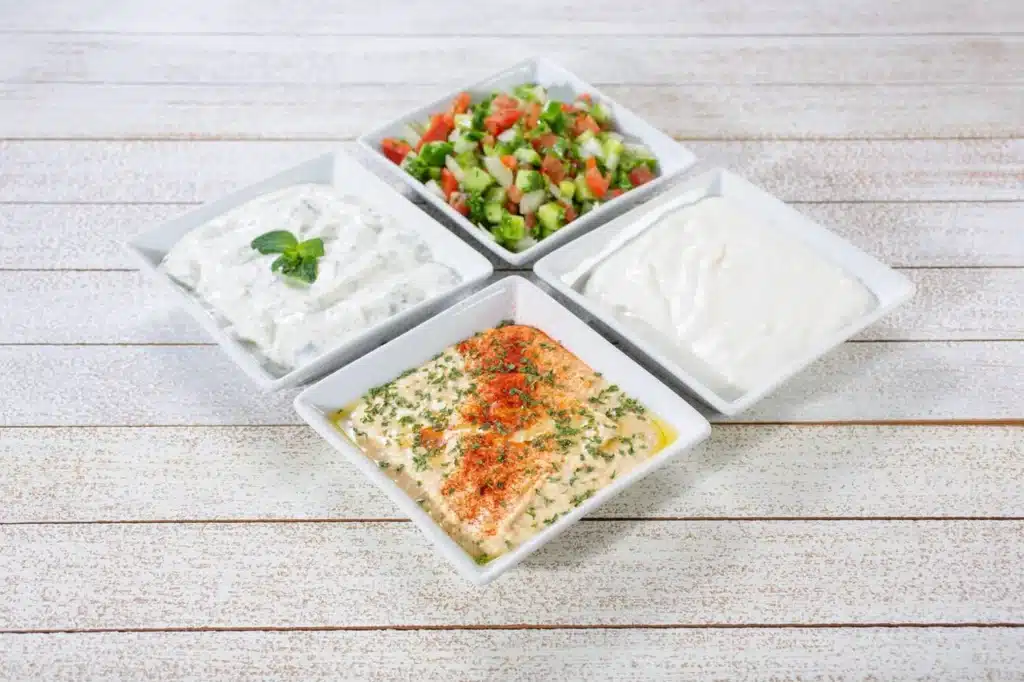
Dairy (Labaniyat)
Dairy, especially yogurt, plays a central role in Persian meals. It’s used as a base for dips like mast-o-khiar, as well as in soups and marinades, offering a creamy texture and balancing the flavors in Persian cuisine.
Essential Spices and Flavoring Agents
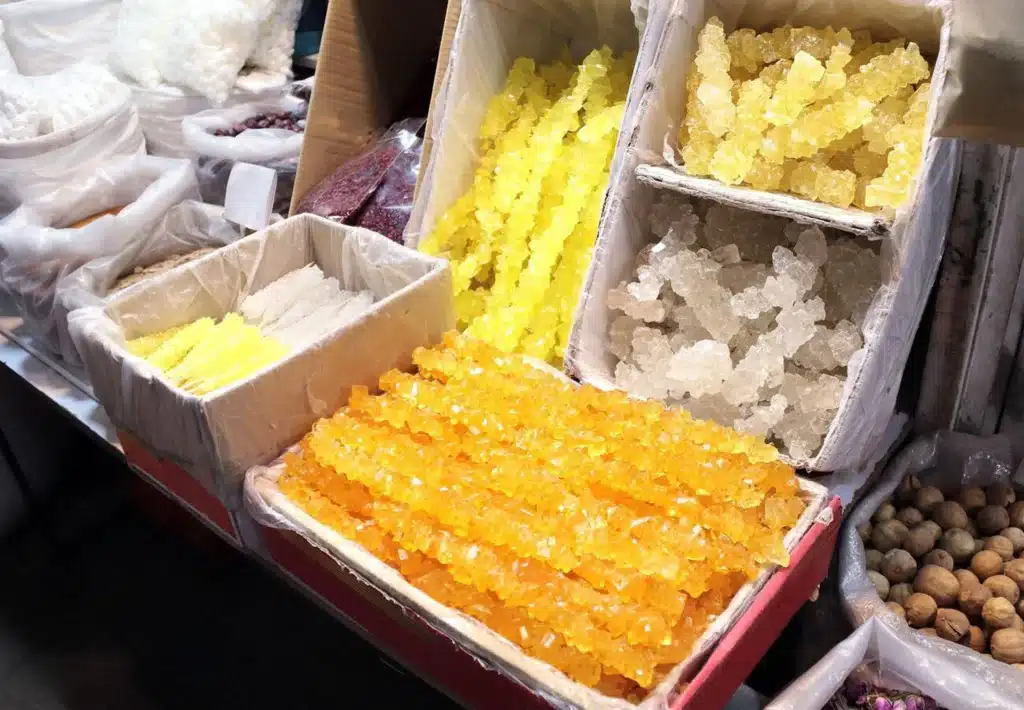
Saffron (Zaffran)
Saffron is the crown jewel of Persian spices. It adds a luxurious golden color and a distinctive floral aroma to rice, stews, and desserts, making it a key ingredient in Persian culinary traditions.
Turmeric (Zardchubeh)
Turmeric is a staple spice in Iranian cooking, known for its warm, earthy flavor. It is commonly used in khoresh (Persian stews), lending depth and color to many dishes.
Cinnamon (Darchin)
Cinnamon is often used in Persian rice dishes and stews. It imparts a subtle sweetness that balances savory flavors, making it an essential component of Persian spice blends.
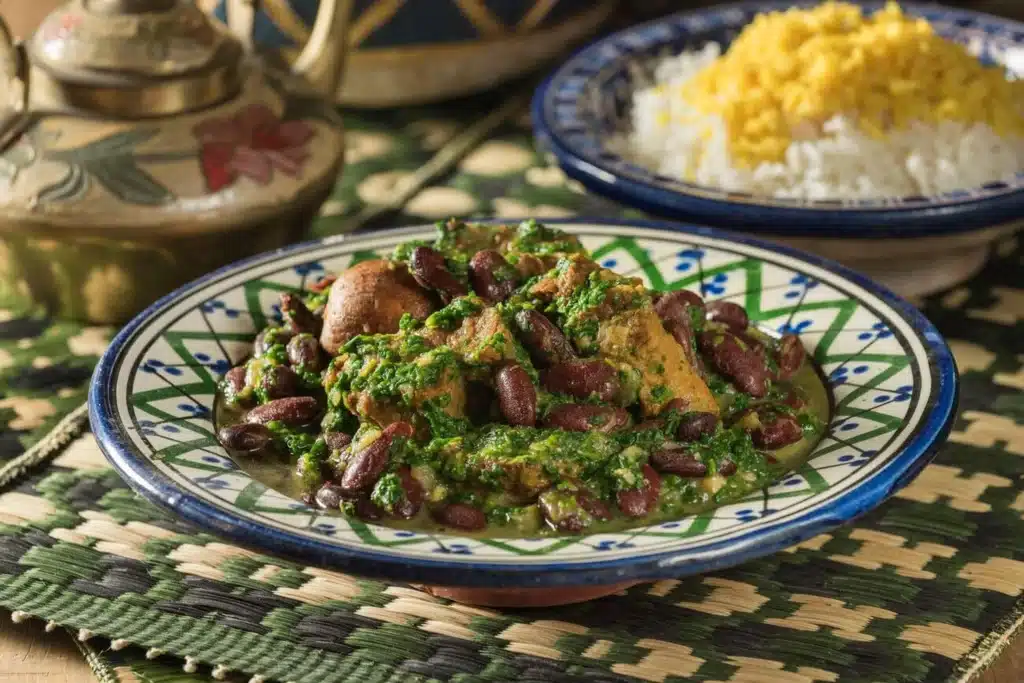
Dried Lime (Limoo Amani)
Dried limes, also known as Limoo Amani, bring a tangy, slightly bitter depth to stews such as Gheymeh and Ghormeh Sabzi. They are a distinctive feature of Persian cooking, adding complexity to the flavor profile.
Rosewater (Golab)
Rosewater is commonly used in Persian desserts and beverages. Its delicate floral essence elevates the taste of sweets like baklava and faloodeh, giving them a unique aroma and flavor.
Sumac
Sumac is a tangy, citrusy spice frequently sprinkled over kebabs and rice dishes. It adds a hint of acidity, enhancing the overall balance of flavors in Persian cuisine.
Cardamom, Cumin, and Coriander
These spices are essential in Persian cooking, adding warmth and complexity to dishes. They are often used in combination with nuts and dried fruits, contributing to the intricate flavor profiles of stews and rice dishes.
Flavor Balancing: The Persian Culinary Philosophy
Persian cuisine is built on a delicate equilibrium of sweet, sour, and salty flavors. Many dishes incorporate fruit for natural sweetness, dried lime or vinegar for acidity, and spices or nuts for depth. This balance is especially evident in stews like Fesenjan, where pomegranate molasses provides a rich sweetness that is countered by the slight bitterness of walnuts and the savory essence of slow-cooked meat.
Traditional Cooking Techniques in Persian Cuisine
Persian cuisine is known for its slow-cooked stews, expertly grilled meats, and delicate rice preparations. The cooking process is often labor-intensive, requiring patience to bring out the flavors.
Stewing (Khoresh Pazi)
Persian stews, or khoresh, are slow-cooked over low heat for hours, allowing the flavors to meld. Key ingredients like meat, legumes, and vegetables absorb the richness of saffron, turmeric, and dried limes. Dishes such as Ghormeh Sabzi (herb stew) and Fesenjan (pomegranate walnut stew) showcase this technique.
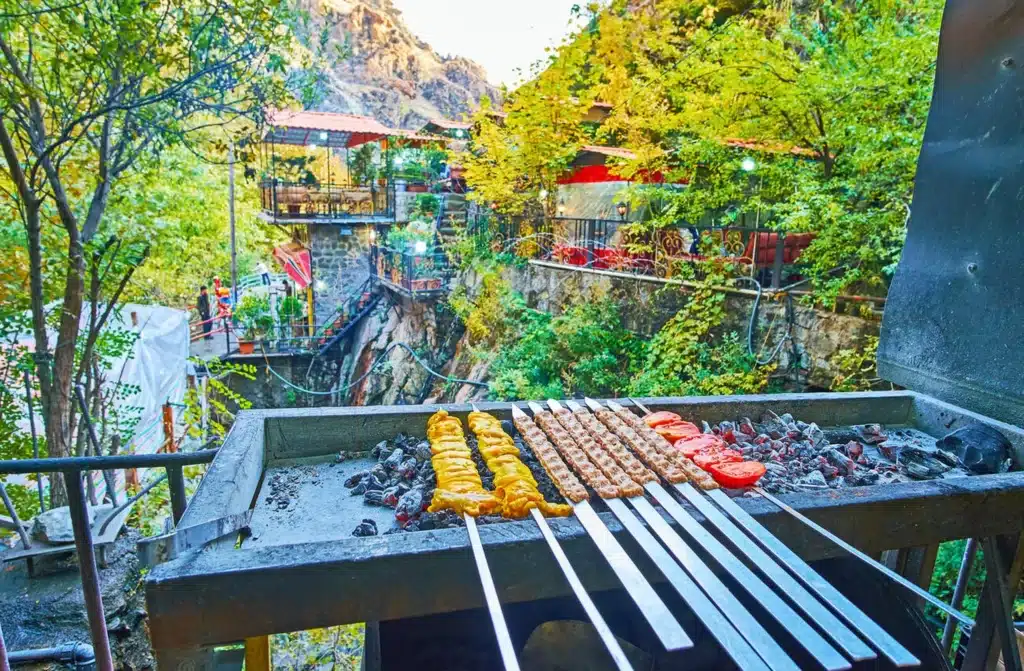
Grilling (Kabob Pazi)
Grilling is at the heart of Persian cuisine, especially kebabs. Meat is often marinated in saffron, yogurt, or citrus before being skewered and grilled over open flames for a smoky, charred finish. Popular varieties include:
- Koobideh – Ground lamb or beef seasoned with onions and spices.
- Joojeh Kabob – Saffron-marinated chicken skewers.
- Barg – Tender lamb or beef filet, grilled to perfection.
Baking (Nan Pazi)
Traditional Persian bread, or nan, is an essential part of meals. It’s baked in clay ovens like the tanoor to achieve various types, such as:
- Sangak – Whole wheat flatbread baked on hot stones.
- Barbari – Thick, slightly crispy bread, often topped with sesame seeds.
Rice Cooking (Polo Pazi)
- Steamed Rice (Chelow) – Persian rice is rinsed and parboiled before being steamed, producing fluffy, separate grains, a crucial element in many Persian dishes.
- Crispy Rice (Tahdig) – The coveted golden crust at the bottom of the rice pot, tahdig is made by allowing a thin layer of rice or bread to crisp up in butter or oil, providing a delightful texture contrast.
Braising (Dam Pazi)
Braising is a slow cooking method where meats and vegetables are braised over low heat. This technique ensures tenderness while infusing the dish with spices and herbs, making it a key method for many Persian stews and dishes.
Pickling (Torshi Pazi)
Persian cuisine features a variety of pickled vegetables, or torshi. These tangy pickles add acidity and a refreshing contrast to the richness of stews, rice dishes, and grilled meats.
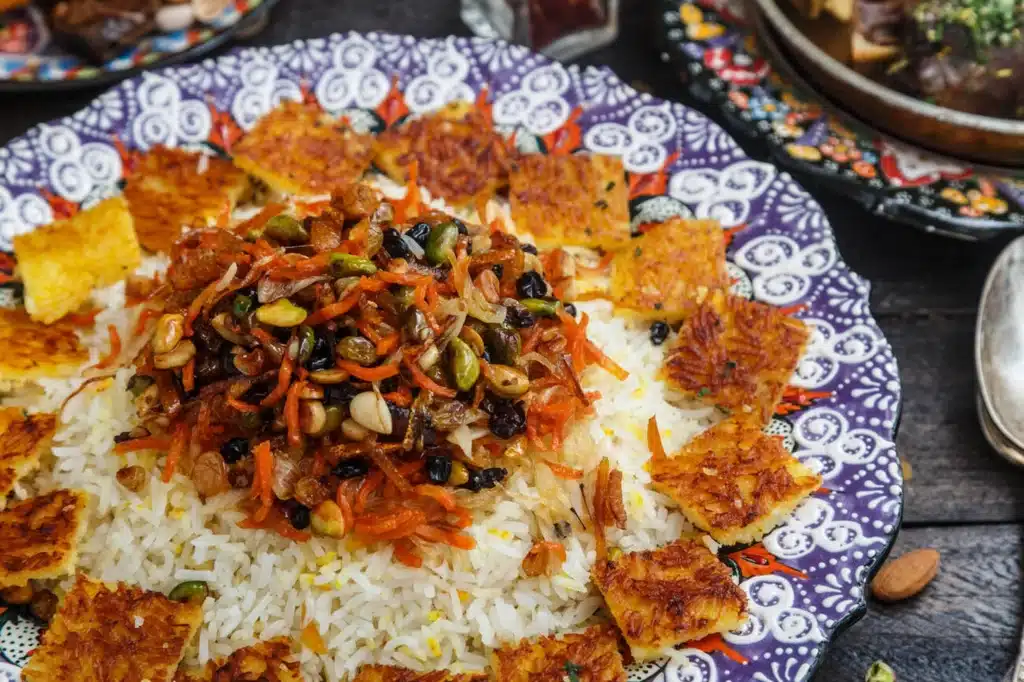
Tahdig Pot (Degcheh)
The Tahdig pot, or Degcheh, is a heavy-bottomed pot used specifically to cook rice, creating its signature crispy crust. This cookware is essential for making tahdig, the golden, crispy layer that forms at the bottom of the pot. Often made of stainless steel or non-stick material, it allows heat to distribute evenly, ensuring that the rice cooks perfectly while achieving a delightful crunch that is highly coveted in Persian cuisine.
Kebab Grill (Mangal)
The Mangal is a traditional charcoal-based grill used to cook skewered meats, particularly kebabs. This essential piece of cookware imparts a smoky flavor to the meat as it grills over open flames. The Mangal ensures an even cook, producing juicy, charred kebabs that are a cornerstone of Persian dining. Traditionally, the Mangal is a portable grill, making it perfect for outdoor cooking and gatherings, where families and friends enjoy grilled meats in a communal setting.
Clay Pots (Khoresh Pazi Pot)
Clay pots, or Khoresh Pazi Pot, are widely used for slow-cooking stews in Persian cuisine. The natural material helps retain moisture and evenly distribute heat, allowing flavors to develop gradually. This slow cooking technique results in tender meats, rich broths, and complex flavors. Clay pots are particularly favored for making dishes like Ghormeh Sabzi (herb stew) and Fesenjan (pomegranate walnut stew), where the ingredients benefit from a long, simmering process that enhances the taste. Some versions of these pots have a lid that helps lock in heat and moisture, further contributing to the richness of Persian stews.
Tanoor Oven
The Tanoor is a traditional clay oven used for baking Persian bread, such as Sangak and Barbari. It features a cylindrical shape, with the bread baked by sticking it to the inner walls of the oven, which is heated by a wood or coal fire. The high temperature and radiant heat from the oven produce a distinctive texture in the bread, resulting in a crispy outer crust while keeping the inside soft and airy. The Tanoor oven has been used for centuries and remains a vital tool in Persian kitchens, particularly in rural areas.
Copper Cooking Pots (Gav-e-Vahshi)
Copper pots, known as Gav-e-Vahshi, are traditional cookware used for preparing Persian stews and soups. Copper has excellent heat conduction properties, making it ideal for cooking at controlled temperatures. These pots are particularly appreciated for their ability to retain and distribute heat evenly, ensuring that dishes like Khoresh Gheymé or Ash Reshteh (noodle soup) cook thoroughly and develop deep flavors. The distinct reddish hue of the copper adds a touch of tradition and beauty to Persian kitchens.
Iconic Iranian Dishes
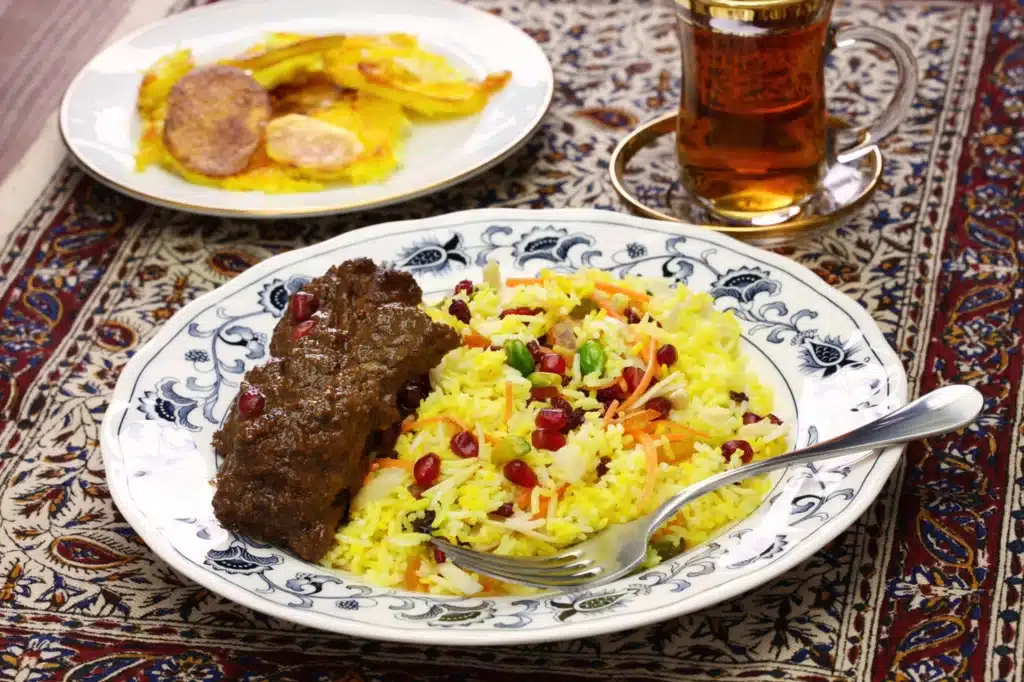
Fesenjan (Pomegranate and Walnut Stew)
Fesenjan is one of Iran’s most beloved and ancient dishes, dating back to the Persian Empire. This rich and tangy stew is made with slow-cooked ground walnuts and pomegranate molasses, giving it a deep, slightly sweet, and sour flavor. Traditionally, Fesenjan is prepared with duck, chicken, or lamb, but vegetarian versions also exist. This dish is particularly popular in northern Iran, where pomegranates and walnuts are abundant.
Popular Kebabs in Iranian Cuisine
Joojeh Kabab
Joojeh Kabab consists of marinated chicken skewers, grilled over an open flame to achieve a smoky, charred flavor. The chicken is typically marinated in saffron, yogurt, lemon, and spices, which tenderizes the meat and infuses it with a fragrant, zesty taste. Joojeh Kabab is a beloved Persian food, with marinated chicken skewers grilled over an open flame for a smoky, charred flavor, often served with saffron rice and grilled tomatoes. This variety is a popular choice for gatherings and is often served with saffron rice (chelow) and grilled tomatoes, making it a staple of Persian BBQs.
Koobideh
Koobideh is a classic Persian kebab made from ground lamb or beef mixed with finely chopped onions and a variety of spices. The meat is shaped onto skewers and grilled to perfection, resulting in juicy, flavorful kebabs. Koobideh is typically served with chelow rice, fresh herbs, and grilled vegetables, offering a balance of savory and aromatic flavors. It’s one of the most widely enjoyed kebabs in Iran.
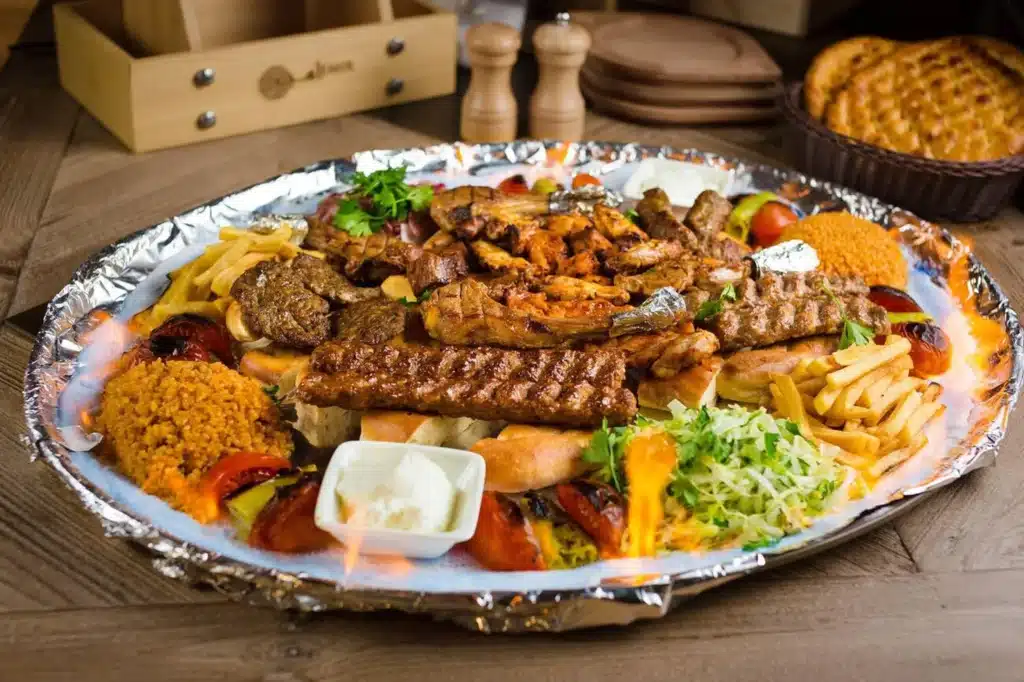
Barg
Barg refers to thinly sliced, marinated beef or lamb fillet, expertly grilled until tender and served alongside chelow rice. The meat is marinated in a blend of olive oil, onions, lemon juice, and saffron to enhance its natural flavors. This kebab is known for its rich taste and tender texture, and it’s often accompanied by grilled tomatoes and a sprinkling of sumac for added zest.
Shishlik
Shishlik is a type of kebab made from juicy, marinated lamb ribs, grilled over an open flame. It is particularly popular in the city of Mashhad and is often served on special occasions. Shishlik, a delicious Persian food, features marinated lamb ribs grilled over an open flame, often served with saffron rice and grilled tomatoes. The ribs are marinated in a mixture of yogurt, saffron, garlic, and spices, which infuses the meat with a deep, flavorful taste. Shishlik is typically served with saffron rice, grilled tomatoes, and a drizzle of melted butter, creating a sumptuous dish that’s enjoyed by families and guests alike.
Serving Kebabs
Kebabs in Iran are typically served with saffron rice (chelow), which is often accompanied by grilled tomatoes, fresh herbs, and a sprinkle of sumac to add tanginess. The combination of flavors and textures makes Persian kebabs a favorite in Iranian cuisine, especially at gatherings and celebrations. The grilled meats, paired with aromatic rice and fresh sides, create a balanced and flavorful meal.
Ghormeh Sabzi (Herb and Lamb Stew)
Often referred to as Iran’s national dish, Ghormeh Sabzi is a slow-cooked herb stew made with parsley, cilantro, fenugreek, and dried limes. The stew is typically prepared with lamb, red kidney beans, and turmeric, giving it a distinct herbal and citrusy aroma. It is enjoyed throughout Iran but is particularly popular during family gatherings and celebrations.
Tahdig (Crispy Rice Crust)
No Persian meal is complete without Tahdig, the golden, crispy layer of rice that forms at the bottom of the pot during cooking. It can be made using plain rice, potatoes, or thin bread (lavash). Tahdig is often served as a prized side dish or as a crunchy topping for rice-based meals.
Zereshk Polo (Barberry Rice with Chicken)
Zereshk Polo is a festive dish featuring fluffy saffron rice mixed with barberries (zereshk), which provide a tangy contrast. The dish is usually served with saffron-marinated chicken and garnished with pistachios or almonds.
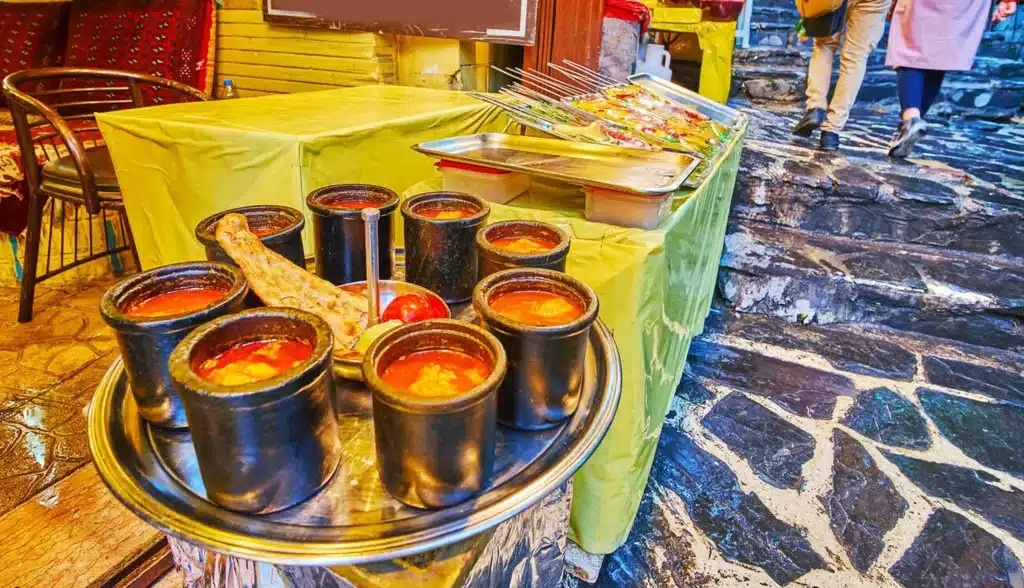
Dizi (Abgoosht – Persian Lamb Stew)
Dizi is a traditional slow-cooked dish made with lamb, chickpeas, potatoes, tomatoes, and spices. The broth is often separated and enjoyed as a soup, while the remaining ingredients are mashed and eaten with Persian flatbread.
Baghali Polo (Fava Bean and Dill Rice with Lamb Shank)
Baghali Polo is a fragrant and flavorful rice dish cooked with dill and fava beans, often served with tender lamb shank. This dish is particularly popular in spring when fresh fava beans are in season.
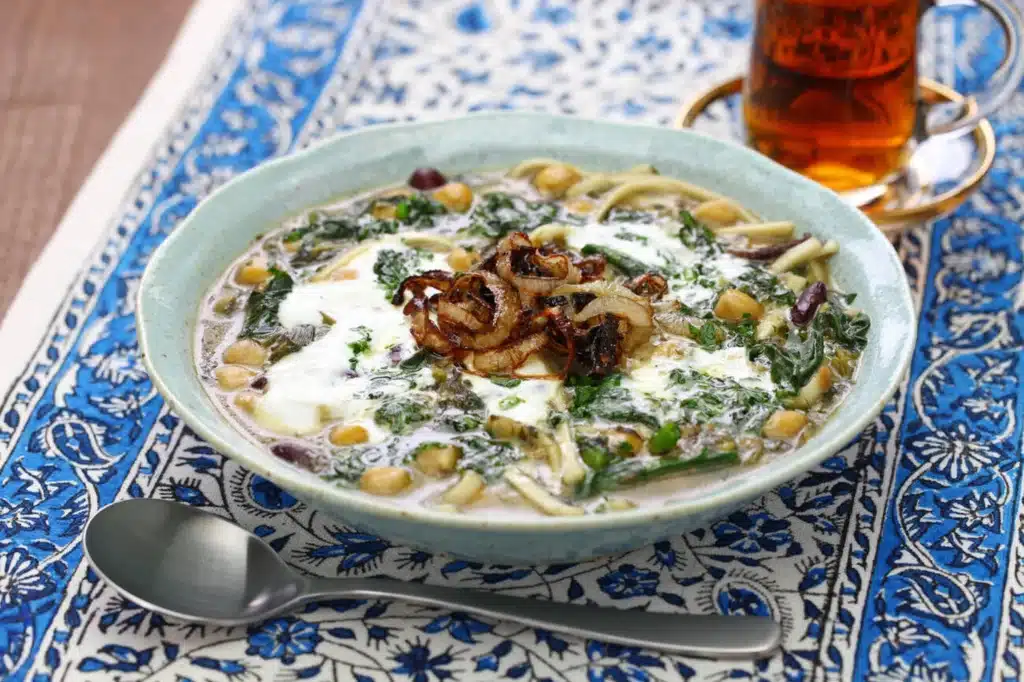
Ash Reshteh (Herb and Noodle Soup)
This thick and hearty soup is made with lentils, beans, noodles, and a variety of herbs. It is topped with fried onions, mint oil, and kashk (fermented whey), giving it a rich and creamy texture. Ash Reshteh is traditionally served during Persian New Year (Nowruz) and other celebrations.
Khoresht-e Bademjan (Eggplant and Tomato Stew)
This flavorful eggplant stew is made with tomatoes, saffron, dried limes, and tender lamb or beef. It is often served with rice and is a staple in many Iranian households.
Sholeh Zard (Saffron Rice Pudding)
Sholeh Zard is a traditional Persian dessert made from rice, saffron, sugar, rosewater, and almonds. The dish is delicately flavored and often garnished with cinnamon and pistachios.
Regional Specialties in Iranian Cuisine
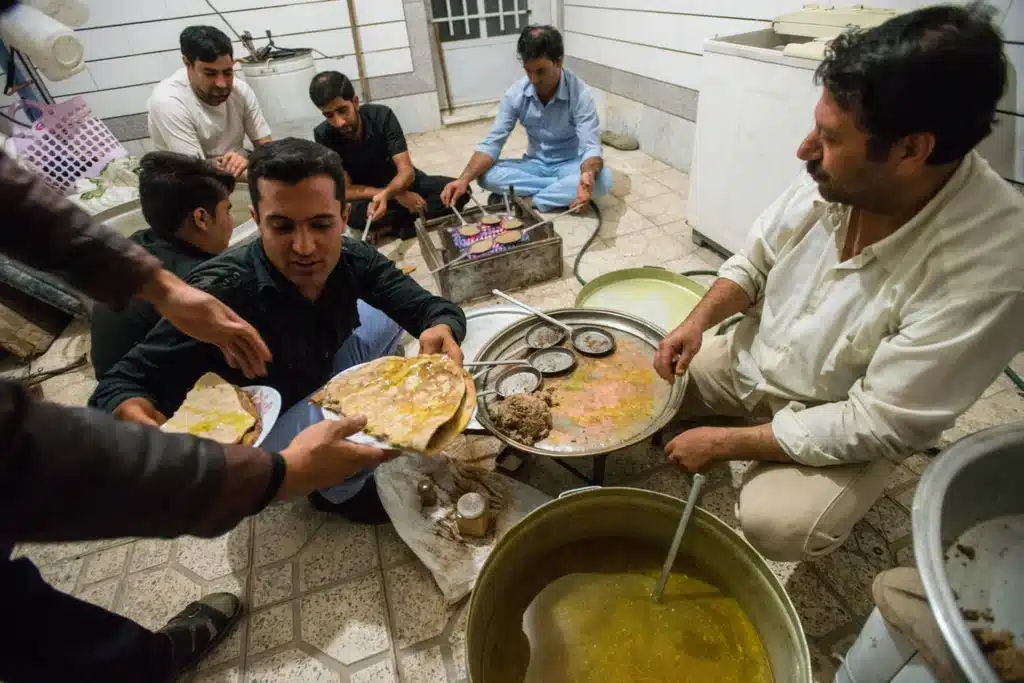
Isfahan: Biryani
Biryani in Isfahan is different from Indian biryani. It consists of ground lamb or beef, cooked with cinnamon and spices, and served over flatbread instead of rice. The dish is usually paired with a bowl of broth.
Shiraz: Kalam Polo (Cabbage Rice)
A Shirazi specialty, Kalam Polo is a savory rice dish with cabbage, small meatballs, and fragrant herbs. It is known for its light yet satisfying taste and is often served with yogurt-based sides.
Yazd: Gheymeh Yazdi
A local variation of Gheymeh (split pea stew), this Yazdi specialty includes lamb, split peas, dried limes, and cinnamon, giving it a warm, spiced flavor.
Mazandaran: Morgh-e Torsh (Sour Chicken Stew)
This northern Iranian dish features chicken slow-cooked with pomegranate paste, walnuts, garlic, and aromatic herbs, creating a delicious balance of sweet and sour flavors.
Kerman: Boz Ghormeh
Boz Ghormeh is a goat meat stew prepared with chickpeas, dried limes, and garlic. The dish is slowly simmered to develop a deep, rich flavor.
Hormozgan: Ghalieh Mahi (Spicy Fish Stew)
Popular along the Persian Gulf, this spicy fish stew is made with coriander, fenugreek, tamarind, and chili peppers, reflecting the influence of Indian and Arabic cuisines.
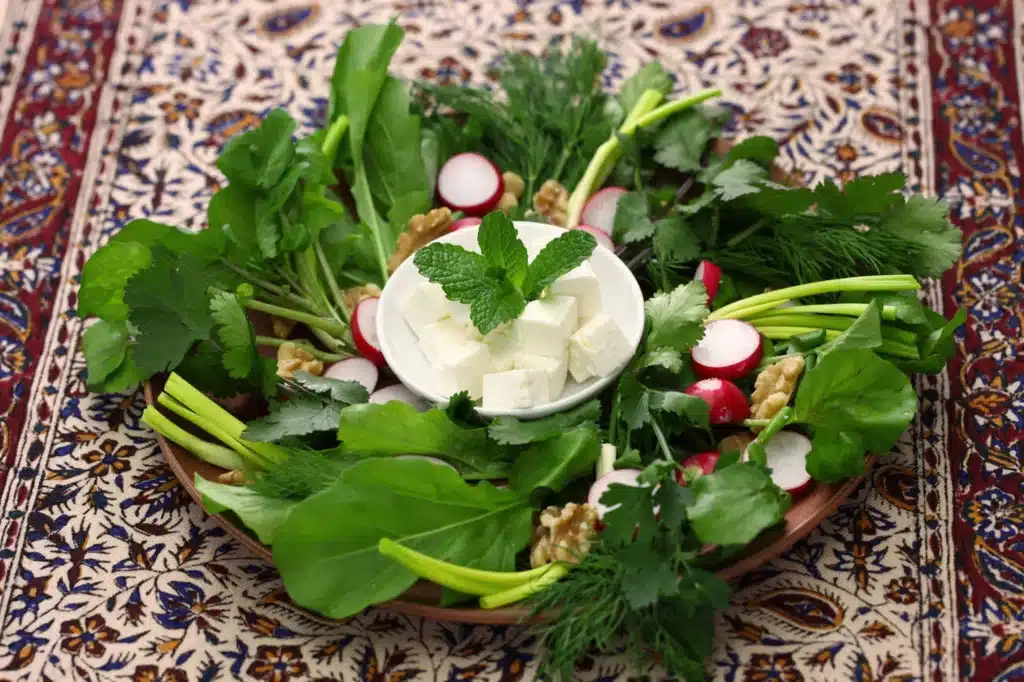
Structure of an Iranian Meal
Iranian meals are traditionally served family-style, with multiple dishes presented at the table simultaneously. A typical meal structure consists of:
1. Appetizers (Mazeh)
Mazeh refers to small dishes that are served at the beginning of a meal. These may include:
- Sabzi Khordan – A platter of fresh herbs, radishes, walnuts, and feta cheese, often enjoyed with bread.
- Kashk-e Bademjan – A creamy eggplant dip topped with whey and fried onions.
- Mast-o-Khiar – A refreshing yogurt and cucumber dip with dried mint.
- Olivier Salad – A Persian version of Russian salad, featuring chicken, potatoes, eggs, and mayonnaise.
2. Main Courses
Iranian main courses are often centered around rice (polo) and stew (khoresh), with grilled meats playing a significant role.
- Chelow Kabab – The national dish of Iran, consisting of saffron rice and various grilled kebabs.
- Ghormeh Sabzi – A slow-cooked stew of herbs, dried limes, and lamb, served with rice.
- Fesenjan – A pomegranate and walnut stew with duck or chicken.
- Baghali Polo – Rice with dill and fava beans, commonly served with lamb shank.
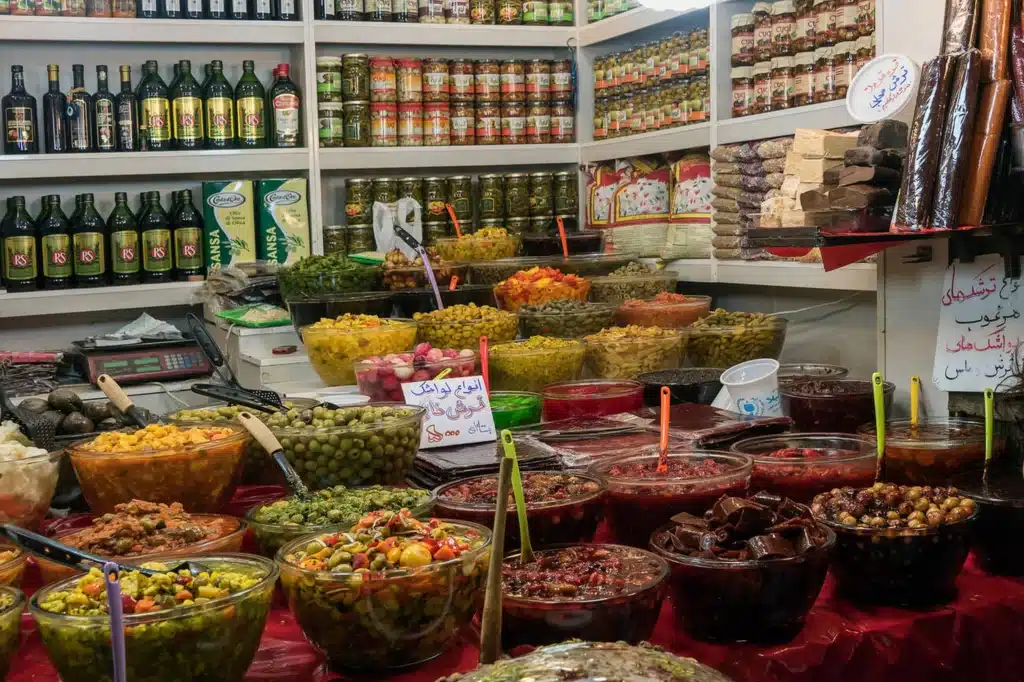
3. Accompaniments
- Torshi – Pickled vegetables that add a tangy contrast to meals.
- Shirazi Salad – A mix of diced cucumbers, tomatoes, onions, and lemon juice.
- Doogh – A yogurt-based beverage often served alongside meals.
4. Desserts & Tea
- Sholeh Zard – Saffron rice pudding topped with cinnamon and almonds.
- Bastani Sonnati – Persian saffron and rosewater ice cream.
- Chai (Tea) – Served in small glasses, often accompanied by sugar cubes or dates.
Dining Etiquette in Iran
Iranian dining customs emphasize hospitality, respect, and communal eating. Here are some key aspects of Iranian dining etiquette:
Seating Arrangements
- Meals are traditionally served on a sofreh (a fabric spread on the floor), though modern families often use dining tables.
- Guests are seated in a place of honor, and elders are given priority in seating and serving.
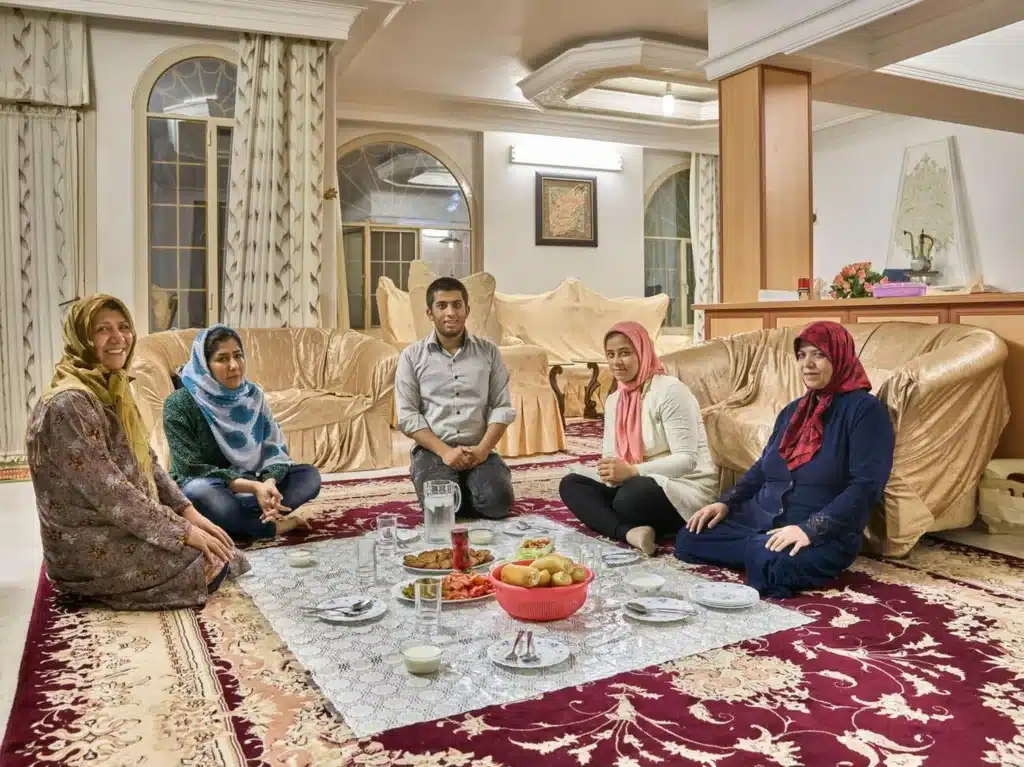
Serving and Sharing
- Food is often shared communally, with large platters placed in the center for everyone to enjoy.
- The host usually serves guests first and encourages them to eat more.
- It is considered polite to offer food to others before serving oneself.
Table Manners
- Using the right hand to eat and pass food is customary.
- Bread is often used as a utensil to scoop up food.
- Refusing an offer of food multiple times before accepting is a sign of politeness.
- Guests should express gratitude and compliment the host on the meal.
Cultural Significance of Food in Iran
Food in Iran is not just sustenance—it is an expression of culture, hospitality, and tradition.
1. Food as a Social Bond
- Iranians value gathering around food as a means of fostering relationships.
- Traditional meals are an opportunity for families and friends to come together, share stories, and strengthen bonds.
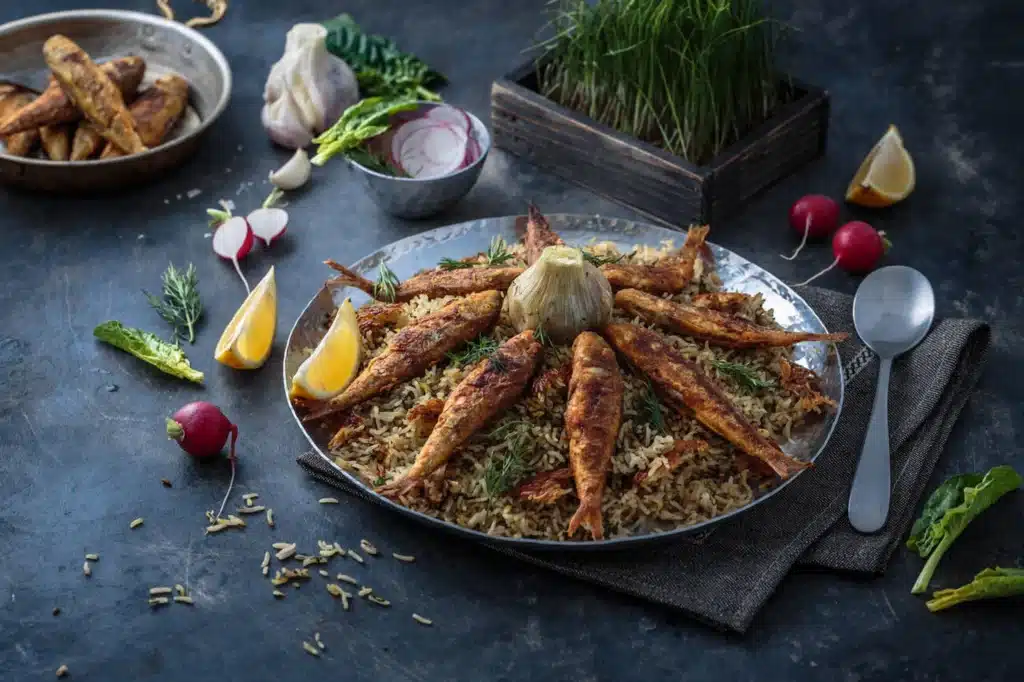
2. Role of Food in Celebrations and Holidays
- Nowruz (Persian New Year): Special dishes like Sabzi Polo (herbed rice with fish) and Samanu (sweet wheat pudding) are prepared.
- Yalda Night: Families gather to eat pomegranates, nuts, and watermelon while reciting poetry.
- Ramadan & Iftar Meals: Dishes such as Ash Reshteh (herb and noodle soup) and dates with tea are common for breaking the fast.
3. The Symbolism of Ingredients
- Saffron represents luxury and hospitality, often used in celebratory dishes.
- Pomegranates symbolize fertility and renewal, making them popular in festive occasions.
- Rice signifies prosperity and abundance, forming the backbone of Iranian cuisine.
Drinks and Desserts in Iranian Cuisine
Iranian cuisine is not only famous for its rich and flavorful main courses but also for its diverse and delightful selection of drinks and desserts. From refreshing yogurt-based beverages to delicate saffron-infused sweets, Iranian drinks and desserts play a significant role in complementing meals and enhancing celebrations.
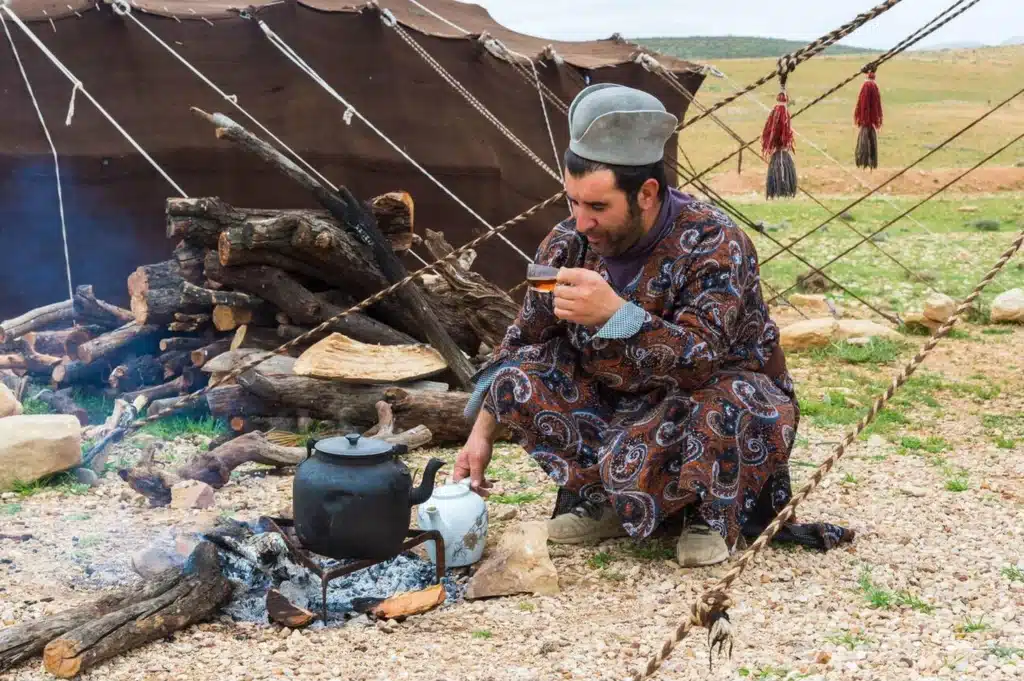
Traditional Iranian Beverages
1. Chai (Persian Tea)
Tea, or Chai, is the most popular drink in Iran and is consumed throughout the day. It is typically brewed strong and served in small glasses with sugar cubes, nabat (saffron rock candy), or dates. Iranians often pour the tea into a saucer to cool before sipping it.
2. Doogh (Yogurt Drink)
A refreshing and slightly carbonated yogurt-based drink, Doogh is commonly flavored with dried mint and sometimes mixed with cucumber. It is a staple accompaniment to grilled meats and rice dishes, balancing the richness of Persian cuisine with its tangy and cooling effect.
3. Sharbat (Herbal Syrups)
Sharbat refers to a variety of sweet, flavored syrups mixed with chilled water and sometimes garnished with fresh herbs or rose petals. Popular varieties include:
- Sharbat-e Golab (Rosewater syrup)
- Sharbat-e Zaferan (Saffron syrup)
- Sharbat-e Sekanjebin (Mint and vinegar syrup, often served with grated cucumbers)
4. Ab Havij (Carrot Juice)
Freshly squeezed carrot juice is a common street-side refreshment. It is sometimes paired with Bastani Sonnati (Persian saffron ice cream) to create a unique, creamy float known as Havij Bastani.
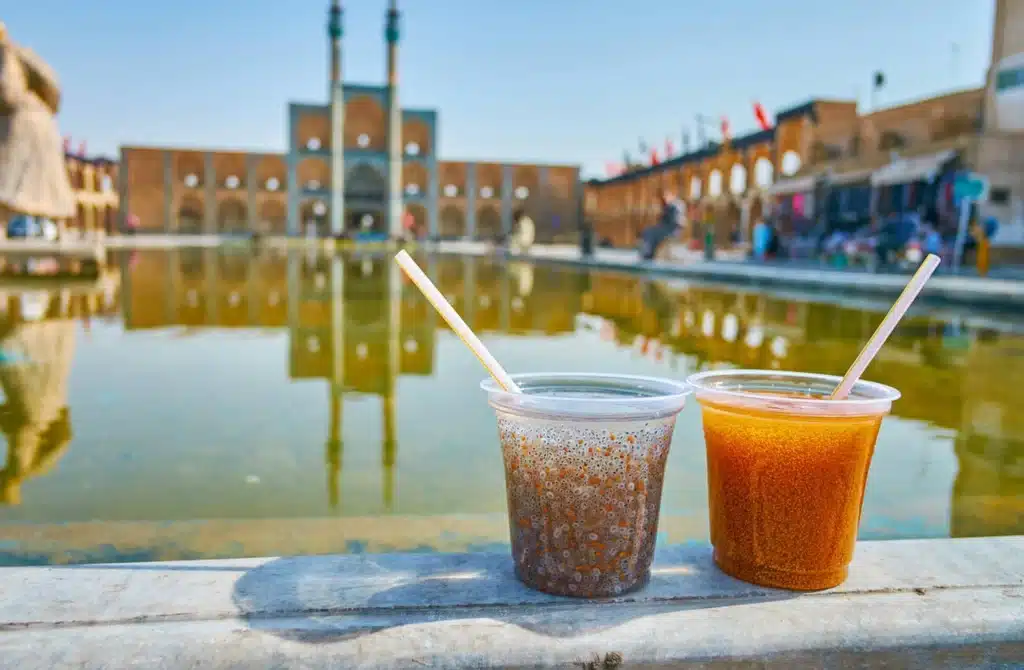
5. Khakshir (Flixweed Drink)
A traditional summer beverage, Khakshir consists of tiny flixweed seeds mixed with water, sugar, and sometimes rosewater. It is believed to have cooling properties and is often consumed to combat heat.
6. Tokhm Sharbati (Basil Seed Drink)
Similar to chia seed drinks, Tokhm Sharbati is made by soaking basil seeds in water, creating a gelatinous texture. It is often mixed with sharbat syrups for a flavorful and nutritious refreshment.
7. Persian Coffee (Qahveh)
While tea is the preferred drink in Iran, Persian coffee is still enjoyed, particularly in southern regions. It is often brewed strong and spiced with cardamom.
Traditional Iranian Desserts
1. Bastani Sonnati (Persian Saffron Ice Cream)
This creamy, saffron-infused ice cream is enriched with rosewater, pistachios, and frozen chunks of clotted cream (khameh). It is a popular summertime treat and often paired with carrot juice for Havij Bastani.
2. Faloodeh (Persian Frozen Vermicelli Dessert)
Faloodeh is a unique frozen dessert made from thin vermicelli noodles soaked in semi-frozen syrup flavored with rosewater and lime juice. It is typically served with sour cherry syrup or lemon juice for a tangy-sweet contrast.
3. Baklava
Iranian Baklava is different from its Turkish or Greek counterparts, as it is typically flavored with rosewater, cardamom, and ground nuts such as pistachios or almonds. It is delicately layered and soaked in a light syrup, making it less heavy than other variations.
4. Ranginak (Date and Walnut Pastry)
A specialty from southern Iran, Ranginak is made with dates stuffed with walnuts, covered in a buttery flour and cinnamon mixture, and garnished with crushed pistachios.
5. Sholeh Zard (Saffron Rice Pudding)
This fragrant rice pudding is cooked with saffron, rosewater, sugar, and cinnamon, then garnished with almonds and pistachios. It is often prepared for religious ceremonies and special occasions.
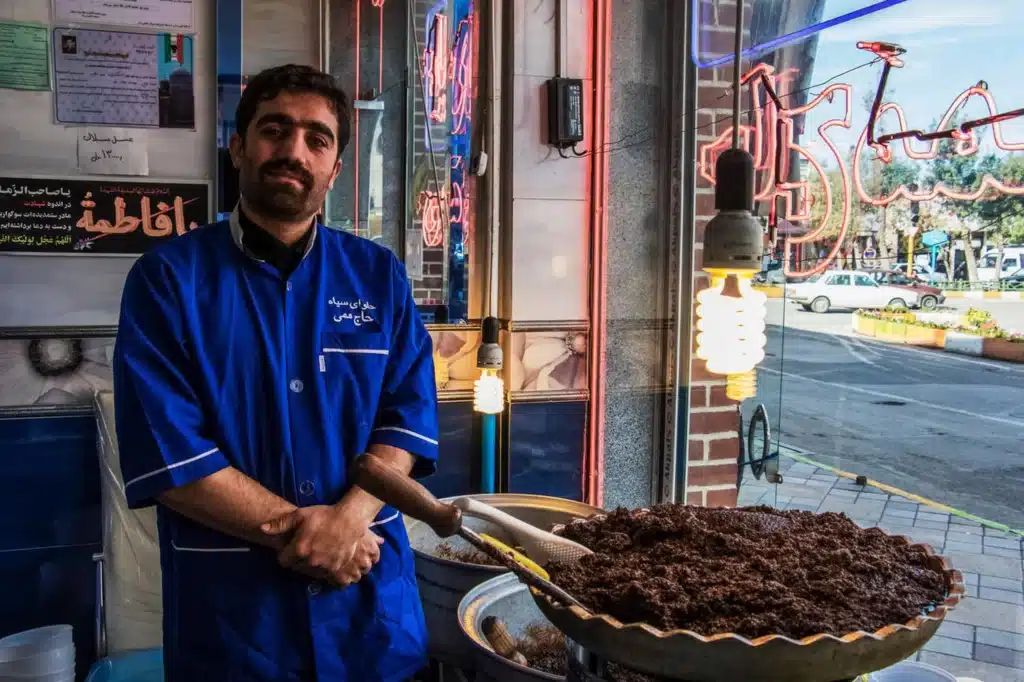
6. Halva
Iranian Halva is a sweet, dense confection made from wheat flour, butter, saffron, rosewater, and sugar syrup. It is often served at funerals or religious gatherings.
7. Zoolbia & Bamieh
These are deep-fried Persian sweets soaked in saffron and rosewater syrup. Zoolbia is crispy and spiral-shaped, while Bamieh resembles small doughnuts.
8. Koloocheh (Persian Stuffed Cookies)
These buttery cookies are filled with spiced date paste, nuts, or coconut and are especially popular in northern Iran.
9. Qottab
A Yazdi delicacy, Qottab is a deep-fried pastry filled with almonds, cardamom, and powdered sugar, offering a crunchy and aromatic experience.
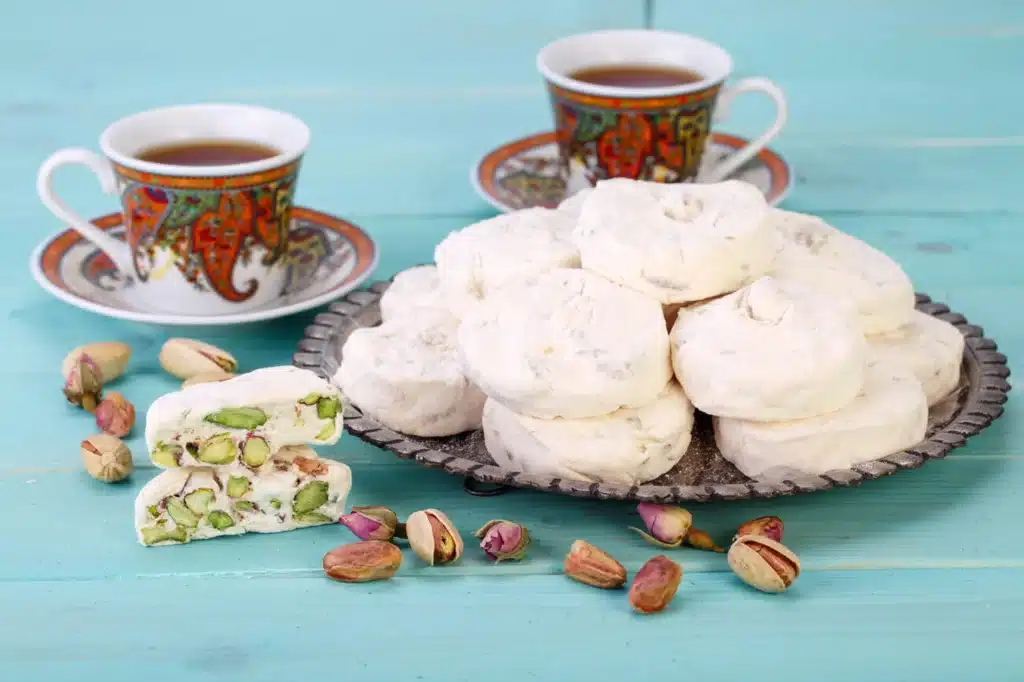
10. Gaz (Persian Nougat)
A specialty from Isfahan, Gaz is a chewy nougat made with pistachios or almonds, flavored with rosewater and natural wildflower honey.
Conclusion
Iranian cuisine is a culinary mosaic woven with history, culture, and geography. From the aromatic rice dishes infused with saffron to the hearty stews, savory kebabs, and delicate desserts, each dish tells a story of centuries-old traditions and regional influences. The depth of flavors, the artful use of spices, and the balance between sweet, sour, and savory make Iranian food a truly unique gastronomic experience.
Beyond its delicious flavors, Iranian cuisine reflects the values of hospitality and communal dining. Meals are often shared with loved ones, bringing people together in a warm and inviting atmosphere. Whether enjoying a simple home-cooked dish or indulging in an elaborate feast, Persian food fosters connection and a sense of belonging.
Exploring Iranian cuisine is not just about tasting new flavors; it is about embracing a culture rich in history and tradition. Each dish, from Ghormeh Sabzi to Fesenjan, offers a glimpse into Iran’s diverse landscapes and its people’s deep-rooted appreciation for food as an art form. The traditional drinks, from chai to doogh, further enhance the dining experience, showcasing the integral role of beverages in Persian culinary customs.
As global interest in international cuisine grows, Iranian food stands as a testament to the richness of Middle Eastern gastronomy. Whether through home-cooked meals, visits to Persian restaurants, or food festivals, there are countless ways to explore and appreciate this vibrant culinary heritage.
For those who seek to broaden their palates and deepen their appreciation for world flavors, Iranian cuisine offers an unforgettable journey. From its ancient roots to its modern-day interpretations, Persian food continues to captivate and inspire food lovers across the globe. Embark on this flavorful adventure and experience the magic of Iranian cuisine—one bite at a time.






